Unit - 2
Numerical Solution of Differential Equation
The general first order differential equation
 …. (1)
…. (1)
With the initial condition  … (2)
… (2)
In general, the solution of first order differential equation in one of the two forms:
a) A series for y in terms of power of x, from which the value of y can be obtained by direct solution.
b) A set of tabulated values of x and y.
The case (a) is solved by Taylor’s Series or Picard method whereas case (b) is solved by Euler’s, Runge Kutta Methods etc.
Taylor’s Series Method:
The general first order differential equation
 …. (1)
…. (1)
With the initial condition  … (2)
… (2)
Let  be the exact solution of equation (1), then the Taylor’s series for
be the exact solution of equation (1), then the Taylor’s series for  around
around  is given by
is given by
 (3)
(3)
If the values of are known, then equation (3) gives apowwer series for y. By total derivatives we have
are known, then equation (3) gives apowwer series for y. By total derivatives we have
 ,
,


And other higher derivatives of y. The method can easily be extended to simultaneous and higher –order differential equations. In general,

Putting  in these above results, we can obtain the values of
in these above results, we can obtain the values of  finally, we substitute these values of
finally, we substitute these values of  in equation (2) and obtain the approximate value of y; i.e., the solutions of (1).
in equation (2) and obtain the approximate value of y; i.e., the solutions of (1).
Example1: Solve ,
,  using Taylor’s series method and compute
using Taylor’s series method and compute  .
.
Here  This implies that
This implies that  .
.
Differentiating, we get
 .
.
 .
.

 .
.
The Taylor’s series at  ,
,


 (1)
(1)
At  in equation (1) we get
in equation (1) we get


At  in equation (1) we get
in equation (1) we get


Example2: Using Taylor’s series method, find the solution of

At  ?
?
Here 
At  implies that
implies that  or
or  or
or 
Differentiating, we get
 implies that
implies that  or
or  .
.
 implies that
implies that  or
or 
 implies that
implies that  or
or 
 implies that
implies that  or
or 
The Taylor’s series at  ,
,


 (1)
(1)
At  in equation (1) we get
in equation (1) we get



At  in equation (1) we get
in equation (1) we get



Example3: Solve  numerically, start from
numerically, start from  and carry to
and carry to  using Taylor’s series method.
using Taylor’s series method.
Here  .
.

We have 
Differentiating, we get
 implies that
implies that  or
or 
 implies that
implies that  or
or  .
.
 implies that
implies that 
 implies that
implies that 
The Taylor’s series at  ,
,

Or 


Here 





The Taylor’s series


 .
.
The general first order differential equation

With the initial condition 
4.2.1 Euler’s method:
In this method the solution is in the form of a tabulated values.
Integrating both side of the equation (i) we get

Assuming that  in
in  this gives Euler’s formula
this gives Euler’s formula

In general formula
 , n=0,1, 2,….
, n=0,1, 2,….
Error estimate for the Euler’s method



Example1: Use Euler’s method to find y (0.4) from the differential equation
 with h=0.1
with h=0.1
Given equation 
Here 
We break the interval in four steps.
So that 
By Euler’s formula
 , n=0,1,2,3 ……(i)
, n=0,1,2,3 ……(i)
For n=0 in equation (i) we get



For n=1 in equation (i) we get


 .01
.01
For n=2 in equation (i) we get



For n=3 in equation (i) we get



Hence y (0.4) =1.061106.
Example2: Using Euler’s method solve the differential equation for y at x=1 in five steps

Given equation 
Here 
No. Of steps n=5 and so that 
So that 
Also 
By Euler’s formula
 , n=0,1,2,3,4 ……(i)
, n=0,1,2,3,4 ……(i)
For n=0 in equation (i) we get



For n=1 in equation (i) we get



For n=2 in equation (i) we get



For n=3 in equation (i) we get



For n=4 in equation (i) we get



Hence 
Example3: Given  with the initial condition y=1 at x=0.Find y for x=0.1 by Euler’s method (five steps).
with the initial condition y=1 at x=0.Find y for x=0.1 by Euler’s method (five steps).
Given equation is 
Here 
No. Of steps n=5 and so that 
So that 
Also 
By Euler’s formula
 , n=0,1,2,3,4 ……(i)
, n=0,1,2,3,4 ……(i)
For n=0 in equation (i) we get



For n=1 in equation (i) we get



For n=2 in equation (i) we get



For n=3 in equation (i) we get



For n=4 in equation (i) we get



Hence 
4.2.2 Modified Euler’s Method:
Instead of approximating  as in Euler’s method. In the modified Euler’s method, we have the iteration formula
as in Euler’s method. In the modified Euler’s method, we have the iteration formula

Where  is the nth approximation to
is the nth approximation to  .The iteration started with the Euler’s formula
.The iteration started with the Euler’s formula

Example1: Use modified Euler’s method to compute y for x=0.05. Given that

Result correct to three decimal places.
Given equation 
Here 
Take h =  = 0.05
= 0.05
By modified Euler’s formula the initial iteration is

 )
)

The iteration formula by modified Euler’s method is
 -----(i)
-----(i)
For n=0 in equation (i) we get


Where  and
and  as above
as above

For n=1 in equation (i) we get



For n=3 in equation (i) we get



Since third and fourth approximation are equal.
Hence y=1.0526 at x = 0.05 correct to three decimal places.
Example2: Using modified Euler’s method, obtain a solution of the equation

Given equation 
Here 
By modified Euler’s formula the initial iteration is



The iteration formula by modified Euler’s method is
 -----(i)
-----(i)
For n=0 in equation (i) we get


Where  and
and  as above
as above

For n=1 in equation (i) we get



For n=2 in equation (i) we get



For n=3 in equation (i) we get



Since third and fourth approximation are equal.
Hence y=0.0952 at x=0.1
To calculate the value of  at x=0.2
at x=0.2
By modified Euler’s formula the initial iteration is



The iteration formula by modified Euler’s method is
 -----(ii)
-----(ii)
For n=0 in equation (ii) we get


 1814
1814
For n=1 in equation (ii) we get


 1814
1814
Since first and second approximation are equal.
Hence y = 0.1814 at x=0.2
To calculate the value of  at x=0.3
at x=0.3
By modified Euler’s formula the initial iteration is



The iteration formula by modified Euler’s method is
 -----(iii)
-----(iii)
For n=0 in equation (iii) we get



For n=1 in equation (iii) we get



For n=2 in equation (iii) we get



For n=3 in equation (iii) we get



Since third and fourth approximation are same.
Hence y = 0.25936 at x = 0.3
This method is more accurate than Euler’s method.
Consider the differential equation of first order

Let  be the first interval.
be the first interval.
A second order Runge Kutta formula

Where 
Rewrite as

A fourth order Runge Kutta formula:

Where 



Example1: Use Runge Kutta method to find y when x=1.2 in step of h=0.1 given that

Given equation 
Here 
Also 
By Runge Kutta formula for first interval
















Again 
A fourth order Runge Kutta formula:



To find y at 
















A fourth order Runge Kutta formula:



Example2: Apply Runge Kutta fourth order method to find an approximate value of y for x=0.2 in step of 0.1, if

Given equation 
Here 
Also 
By Runge Kutta formula for first interval
















A fourth order Runge Kutta formula:



Again 
















A fourth order Runge Kutta formula:



Example3: Using Runge Kutta method of fourth order, solve

Given equation 
Here 
Also 
By Runge Kutta formula for first interval






 )
)






A fourth order Runge Kutta formula:



Hence at x = 0.2 then y = 1.196
To find the value of y at x=0.4. In this case 










A fourth order Runge Kutta formula:



Hence at x = 0.4 then y=1.37527
The second order differential equation

Let  then the above equation reduces to first order simultaneous differential equation
then the above equation reduces to first order simultaneous differential equation

Then 
This can be solved as we discuss above by Runge Kutta Method. Here  for
for  and
and  for
for  .
.
A fourth order Runge Kutta formula:

Where 



Example1: Using Runge Kutta method of order four, solve  to find
to find 
Given second order differential equation is

Let  then above equation reduces to
then above equation reduces to
Or 
 (say)
(say)
Or  .
.
By Runge Kutta Method we have
















A fourth order Runge Kutta formula:



Example2: Using Runge Kutta method, solve
 for
for  correct to four decimal places with initial condition
correct to four decimal places with initial condition  .
.
Given second order differential equation is

Let  then above equation reduces to
then above equation reduces to
Or 
 (say)
(say)
Or  .
.
By Runge Kutta Method we have
















A fourth order Runge Kutta formula:


And 
 .
.
Example3: Solve the differential equations
 for
for 
Using four order Runge Kutta method with initial conditions 
Given differential equation are

Let 

And 
Also 
By Runge Kutta Method we have
















A fourth order Runge Kutta formula:


And 
 .
.
The general linear partial differential equation of the second order in two independent variables is of the form.

Such a PDE is said to be
- Elliptic: if

- Parabolic: if

- Hyperbolic: if

Example: Classify the equation 
Here 

Hence the equation is parabolic.
Finite Difference Approximation
We construct a rectangular region R in the xy- plane and divide into network of sides  and
and  . The intersection points of the dividing lines are called the mesh point, nodal point or grid points.
. The intersection points of the dividing lines are called the mesh point, nodal point or grid points.
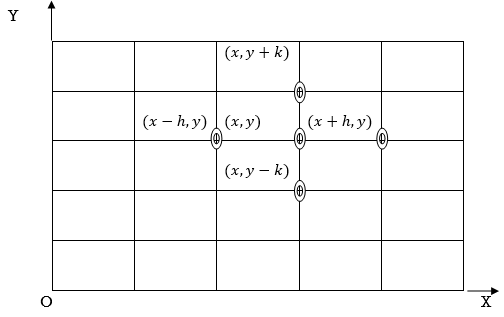
Then the finite difference approximation for the partial derivative in x-direction is



And 
For  the above approximation is
the above approximation is
 …. (1)
…. (1)
 … (2)
… (2)
 … (3)
… (3)
And  … (4)
… (4)
Similarly, we have the approximations for the derivatives with respect to y
 …. (5)
…. (5)
 …. (6)
…. (6)
 … (7)
… (7)
And  …. (8)
…. (8)
Replacing the derivatives in any partial differential equation by their corresponding difference approximation (1) to (8), we obtain the finite difference similar to the given equations.
The Laplace’s equation

Consider the Laplace’s equation in a region R with boundary C. Let R be a square region so that it can be divided into network of small squares of side h. Let the values of  on the boundary C be given by
on the boundary C be given by  and let the interior mesh points be as in figure
and let the interior mesh points be as in figure
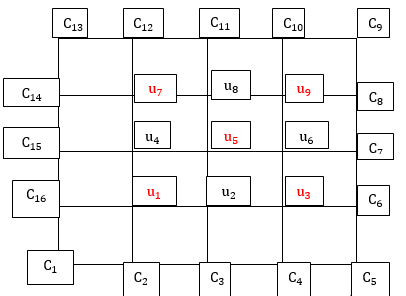
The approximate function values at the interior point of the mesh can be calculated by the diagonal five-point formula of  in this order
in this order
 (bigger +)
(bigger +)
 (X form)
(X form)
 (X form)
(X form)
 (X form)
(X form)
 (X form)
(X form)
Similarly, the remaining quantities are calculated by using standard five-point diagonal formulas.
 (+ form)
(+ form)
 (+ form)
(+ form)
 (+ form)
(+ form)
 (+ form)
(+ form)
In this way all  are computed.
are computed.
Example1: Solve the Laplace’s equation  in the domain
in the domain
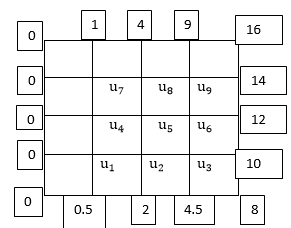
The initial values using five diagonal formula we have
Here  ,
, 





The remaining quantities are calculated by using standard five-point diagonal formulas.




Hence  and
and  .
.
Example2: Solve the Laplace’s equation for
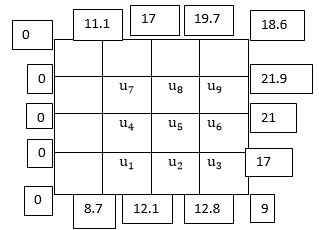
The initial values using five diagonal formula we have
Here  ,
, 





The remaining quantities are calculated by using standard five-point diagonal formulas.




Hence  and
and  .
.
The Laplace’s equation

And the Poisson’s equation

Are the example of elliptic partial differential equation.
The Poisson’s equation

This can be solved by interior mesh points of a square network when the boundary values are known. The standard five-point formula for Poisson’s equation is

After using the above formula, we get the linear equations in the pivotal values 
Then these are solved by Gauss Seidel Iteration formula
 .
.
Example1: Solve the elliptical equation for
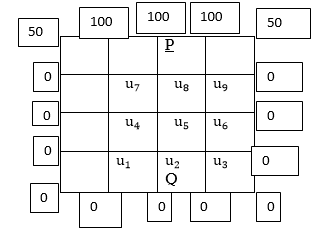
The initial values using five diagonal formula we have
Here  ,
, 





The remaining quantities are calculated by using standard five-point diagonal formulas.




The Above is symmetric about PQ, so that  .
.
We will have iteration process using the Gauss Seidel Formula







First iteration: Putting  we get
we get






Second Iteration: Putting  , we get
, we get






Third Iteration: Putting  , we get
, we get






Fourth Iteration: Putting  , we get
, we get






Fifth iteration: Putting n=4 we get





 .
.
Example2: Solve the Poisson equation

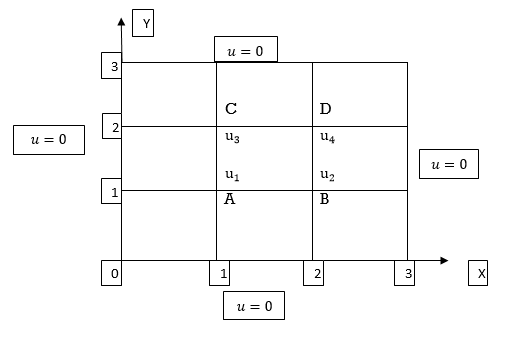
Let the point be defined by  At the point A,
At the point A,  . The standard five-point formula at point A is
. The standard five-point formula at point A is

Or 
Or  ….(i)
….(i)
Again, the standard five-point formula at the point B is

Or 
Or  ...(ii)
...(ii)
Similarly, the standard five-point formula at the point C

Or 
Or  …...(iii)
…...(iii)
Similarly, the standard five-point formula at the point D

Or 
Or  …. (iv)
…. (iv)
From (ii) and (iii) we get  =
= . Hence the iteration formula we have
. Hence the iteration formula we have


 .
.
First iteration: Putting  . Hence, we obtain
. Hence, we obtain



Second iteration: Putting n=1, we get



Third iteration: Putting n=2, we get



Fourth iteration: Putting n=3, we get



Fifth iteration: Putting n=4, we get



Sixth iteration: Putting n=5, we get



Since last two iteration are approximately equal, hence
 .
.
The example of parabolic is one dimensional heat conduction equation
 ... (1)
... (1)
Where  is the diffusivity of the substance.
is the diffusivity of the substance.
Consider a rectangular mesh in  plane.
plane.
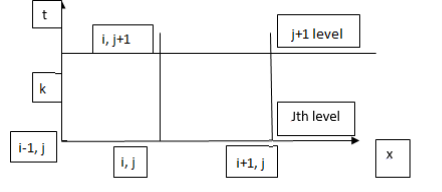
The spacing in x-direction is h and in t direction is k. Let the mesh point  or simply
or simply  we get
we get

And 
Substituting these in equation (1) we get

Or  … (2)
… (2)
Where  is the mesh ratio parameter.
is the mesh ratio parameter.
This formula gives the value of u at position  mesh points I nterms of known values of
mesh points I nterms of known values of  and
and  at the instant
at the instant  . It gives the relation between two-time level therefore known as two level formula.
. It gives the relation between two-time level therefore known as two level formula.
Also named as Schmidt explicit formula and is true for  .
.
At  the above formula reduces to
the above formula reduces to
 ..(3)
..(3)
Is known as Bendre-Schmidt recurrence relation which gives the value of u at internal mesh points with the help of boundary conditions.
Example1: Solve the equation  with the conditions
with the conditions  . Assume
. Assume . Tabulate u for
. Tabulate u for  choosing appropriate value of k?
choosing appropriate value of k?
Here  and let
and let  ,
,
Since 

 The Bendre-Schmidt recurrence formula we have
The Bendre-Schmidt recurrence formula we have
 ….(i)
….(i)
Also given  .
.
 for all values of j, i.e., the entries in the first and the last columns are zero.
for all values of j, i.e., the entries in the first and the last columns are zero.
Since 
 (Using
(Using 
For  .
.
Putting 

Putting  successively we get
successively we get









These will give the entries in the second row.
Putting  in equation (i), we will get the entries of the third row.
in equation (i), we will get the entries of the third row.

Similarly,  successively in (i), the entries of the fourth rows are
successively in (i), the entries of the fourth rows are
Obtained.

Hence the values of  are as given in the below the table:
are as given in the below the table:
 | 0 | 1 | 2 | 3 | 4 | 5 | 6 | 7 | 8 | 9 | 10 |
0 | 0 | 0.09 | 0.16 | 0.21 | 0.24 | 0.25 | 0.24 | 0.21 | 0.16 | 0.09 | 0 |
1 | 0 | 0.08 | 0.15 | 0.20 | 0.23 | 0.24 | 0.23 | 0.20 | 0.15 | 0.08 | 0 |
2 | 0 | 0.075 | 0.14 | 0.19 | 0.22 | 0.23 | 0.22 | 0.19 | 0.14 | 0.075 | 0 |
3 | 0 | 0.07 | 0.133 | 0.18 | 0.21 | 0.22 | 0.21 | 0.18 | 0.133 | 0.07 | 0 |
Example2: Solve the heat equation

Subject to the conditions  and
and

 .
.
Take  and k according to Bendre-Schmidt equation.
and k according to Bendre-Schmidt equation.
Here  and let
and let  ,
,
Since 

 The Bendre-Schmidt recurrence formula we have
The Bendre-Schmidt recurrence formula we have
 …. (i)
…. (i)
Also given  .
.
 for all values of j, i.e., the entries in the first and the last columns are zero.
for all values of j, i.e., the entries in the first and the last columns are zero.
Since 
 .
.

 .
.

For 
Putting 

Putting  successively we get
successively we get



These will give the entries in the second row.
Putting  in equation (i), we will get the entries of the third row.
in equation (i), we will get the entries of the third row.

Similarly,  successively in (i), the entries of the fourth rows are
successively in (i), the entries of the fourth rows are
Obtained.

Hence the values of  are as given in the below the table:
are as given in the below the table:
 | 0 | 1 | 2 | 3 | 4 |
0 | 0 | 0.5 | 1 | 0.5 | 0 |
1 | 0 | 0.5 | 0.5 | 0.5 | 0 |
2 | 0 | 0.25 | 0.5 | 0.25 | 0 |
3 | 0 | 0.25 | 0.25 | 0.25 | 0 |
Example3: Use the Bendre-Schmidt formula to solve the heat conduction problem

With the condition  and
and  .
.
Let  we see
we see  when
when  .
.
The initial condition are  .
.
Also  .
.
The iteration formula is
 =
=
First iteration: Putting n=0, we get



Second iteration: Putting n=1, we get



Third Iteration: putting n=3, we get



Fourth Iteration: putting n=3, we get



Fifth Iteration: putting n=4, we get



Hence the approximate solution is 
References:
- E. Kreyszig, “Advanced Engineering Mathematics”, John Wiley & Sons, 2006.
- P. G. Hoel, S. C. Port and C. J. Stone, “Introduction to Probability Theory”, Universal Book Stall, 2003.
- S. Ross, “A First Course in Probability”, Pearson Education India, 2002.
- W. Feller, “An Introduction to Probability Theory and Its Applications”, Vol. 1, Wiley, 1968.
- N.P. Bali and M. Goyal, “A Text Book of Engineering Mathematics”, Laxmi Publications, 2010.
- B.S. Grewal, “Higher Engineering Mathematics”, Khanna Publishers, 2000.
- T. Veerarajan, “Engineering Mathematics”, Tata Mcgraw-Hill, New Delhi, 2010
- Higher engineering mathematics, HK Dass
- Higher engineering mathematics, BV Ramana.
- Computer based numerical & statistical techniques, M goyal